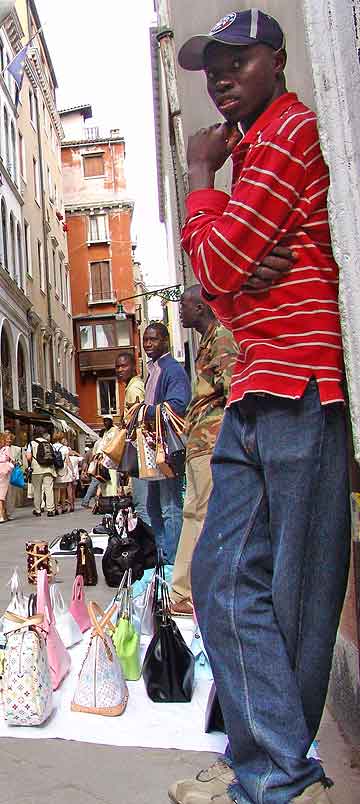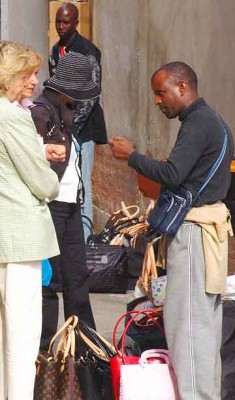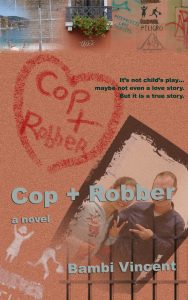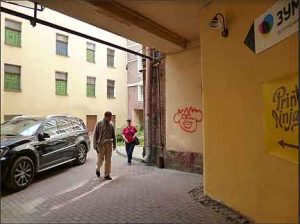
Counterfeit fashion
If you’ve been to Europe, you’ve no doubt had to walk a wide berth around a sheetful of counterfeit handbags laid out on the street. They cause especially annoying bottlenecks in Venice, where the streets are narrow. And of course they draw crowds, furthering the nuisance. You see the African peddlers, too, grabbing up the four corners of their sheets and darting around corners to hide from police.
Bob and I have often wondered why cities can’t get rid of them; but of course, they could. We wonder why stores like Prada allow counterfeits to be sold right outside their doors. And I’ve always assumed the fakes are cheap copies from China.
Reading Gomorrah has opened my eyes. Here’s how the author, Roberto Saviano, describes the high-fashion factory business in and around Naples, Italy.
Factories are small, with about ten employees, often in cramped, poorly lit quarters. In apartments, the backs of stores, any usable space. Even stairwells and hallways. Factories employ highly skilled workers, as sewing is the specialty of the area.
Big fashion houses announce an auction of jobs to factory owners. Interested invitees show up at the time and place. A fashion house rep describes the job: the exact description of the item to be sewn and the number needed.

A factory owner bids on the job by stating a price and the number of days he needs to complete the job. Other owners best the bid, to a certain extent. The winning bid does not win. Instead, all interested (and present) factory owners who’d like to participate under the winning terms, are given, without charge, enough material to complete the job. The factory that completes the job and presents a quality product, is paid. The others are not.
A factory that consistently takes material without ever making the time and quality standards is soon excluded from bidding.
The completed items made by unpaid factories are put on the market. Some get brand names slapped on them, some don’t. Some are sold as authentic, some as counterfeits, some with unknown labels. Some are sold on the streets, some go into local shops, many are exported around the world.
The fashion houses allow this. It’s the way of the industry. It goes for shoes and clothing as well as handbags.
This is all according to Saviano. I’m not finished with the book. Perhaps he’ll reveal a new twist. So far, what he’s described is all Camorra business. On the street, though, the clever Chinese get the credit. Or the blame.
For years, Bob and I have enjoyed shopping in the small boutiques of Naples. We find gorgeous clothes, especially suits, of exceptional fit and quality at ridiculous prices. The labels usually have funny names, like “Alda Mama,” and the shops are gone a year later, but others sprout up in their places. We’ve always been delighted with our purchases in Naples, but had no idea why such fine clothing was sold so cheaply. Now I think I understand why.
I remember when Bob and I first became aware of the extent of Camorra influence in and around Naples. When we innocently asked a shopkeeper about them, he raised a finger and said “Shhh. We don’t talk about the Camorra. We only whisper.”
My previous article about Gomorrah and our snooping among the Camorra crime family in Italy is here.
![]()






6 Comments
[…] efficiently remove. Some locales have enormous illegal black-market replica industries; for example Italy (Naples), Turkey) (Kusadasi & Istanbul, Malaysia (Johor Bahru), Thailand (Bangkok), Vietnam […]
[…] to a bestselling book Gommorah by Roberto Saviano which is now put in award winning film, many of fake goods in Italy are actually made in Italy. Saviano made an extensive research on Naples criminal society that surrounds drug dealing, human […]
Hey!
Amazing blog!!
i stumbled onto it while googling street crime in Barcelona. this is really amazing stuff.
A question… and i really shouldnt be asking this.. but what areas in Naples have the boutiques that you talk about in this article?
Looked up the book. For a song at Amazon UK – £35 dirt cheap. Scary people. Dunno if I want fancy rags that bad I’d go there. Perhaps you can pick up a few things for us! 😉
Thanks, Charlie.
Nice to hear from you again!
GREAT STUFF!!! B-)